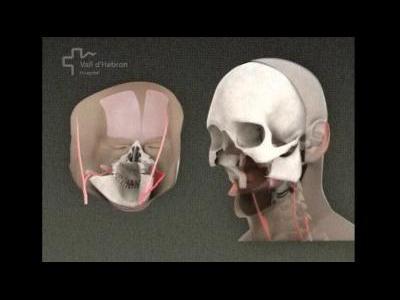MADRID – A team of surgeons has carried out the world's first full-face transplant on a young Spanish farmer unable to breathe or eat on his own since accidentally shooting himself in the face five years ago.
It was the most extensive operation yet and the 11th known face transplant worldwide.
During the 24-hour surgery, doctors lifted an entire face, including jaw, nose, cheekbones, muscles, teeth and eyelids, and placed it masklike onto the man, Dr. Joan Pere Barret told The Associated Press on Friday.
Transplant experts hailed the surgery, carried out late last month at Barcelona's Vall d'Hebron Hospital, as a significant advance.
"It is a breakthrough. They are pushing the envelope and I am very happy for them," said Dr. Thomas Romo, chief of facial andreconstructive surgery at Lenox Hill Hospital in New York.
The Spanish patient, who was not identified, now has a completely new face from his hairline down and only one visible scar, which looks like a wrinkle running across his neck, said Barret, who headed the 30-member surgical team.
The man cannot yet speak, eat or smile, but he can see and swallow saliva, the surgeon said. He is expected to be able to eat and breathe on his own in about a week.
"If you look him in the face, you see a normal person," Barret said. "He sits up, he walks in his hospital room and he watches television."
Before the transplant, the 30-year-old patient had had nine surgeries and could only breathe with the help of a ventilator and get nourishment from a feeding tube. He also had problems speaking.
The 2005 accident, in which he shot himself with a shotgun, essentially destroyed his face from the eye sockets down, although his eyes and eyesight were unaffected.
During the daylong operation, Barret said his team cut off the donor's face below the eye sockets and attached the bone structure along with muscles and nerves to the recipient "in one piece."
"Imagine a skull. It is as if with a saw, we cut everything just below the upper part of the eye sockets, as if we were sawing all that," he said. Then, "everything attached to the mask is placed on the recipient."
"It is a little bit like the movie with John Travolta and Nicolas Cage," the surgeon said, referring to the 1997 thriller "Face/Off", in which the face of the character played by Cage is grafted onto the Travolta character's skull in an identity switch.
Face transplants in the real world have gained acceptance since the first partial transplant almost five years ago in France. Patients don't look like the dead people whose skin and facial features they now live with. And skeptical bioethicists and doctors groups have warmed to the idea for patients who have tried reconstructive surgery with little success.
There have been 10 partial transplants worldwide, including in the United States, China and elsewhere in Spain, but this is the first full face transplant, Barret said.
The Spanish operation is similar to a near-total face transplant carried out by a team led by Dr. Maria Siemionow in 2008 in Cleveland, on a woman who was also shot in the face.
But the Spanish case "seems to us to be more complex," said Neil Huband, a spokesman for the UK Facial Transplantation Research Team, based at the Royal Free Hospital in London.
Barret would give no details about the donor except to say that doctors try to choose donors of similar weight, height, facial measurements and skin tone as the recipient.
As in earlier operations, the Spanish patient had undergone psychiatric tests to determine if he would be able to confront having a totally new face, the hospital said.
Still, rejection is a possibility whenever someone receives an organ or cells from someone else because the body regards this as foreign tissue. Rejection, which can be life-threatening, can come on suddenly, within days or weeks of the operation, or occur years later.
Romo said the patient and doctors are certainly euphoric now but the patient is only beginning to recover and even three years from now his body could reject the face.
"How do you get a patient psychologically ready for that? I think that is a concern that I don't think anybody has dealt with yet," he said.
Unlike operations involving vital organs like hearts and livers, transplants of faces or hands are done to improve quality of life — not extend it. Recipients run the risk of deadly complications and must take immune-suppressing drugs for the rest of their lives to prevent organ rejection, raising their odds of cancer and many other problems.
Still, surgeons say most recipients believe the risk is worth it.
"Absolutely, without a doubt," said Dr. John Barker, director of plastic surgery research at the University of Louisville in Kentucky, of his dealing with hand transplant patients there.
He said surveys his team has done of more than 500 people — including facially disfigured people, surgeons and amputees — give the same result. "It is yes. The risk is worth the benefit."




Tidak ada komentar:
Posting Komentar